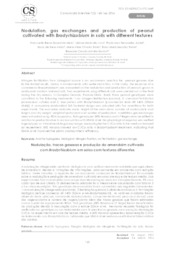Nodulation, gas exchanges and production of peanut cultivated with Bradyrhizobium in soils with different textures.
Nodulation, gas exchanges and production of peanut cultivated with Bradyrhizobium in soils with different textures.
Autoria: MELO, E. B. S. de; LIMA, L. M. de; FERNANDES JUNIOR, P. I.; AIDAR, S. de T.; FREIRE, M. A. O.; FREIRE, R. M. M.; SANTOS, R. C. dos
Resumo: Nitrogen fertilization from biological source is an uncommon practice for peanut growers due to the limited results, mainly in environments with water restriction. In this study, the response of a commercial Bradyrhizobium was evaluated on the nodulation and production of peanuts grown in sandy and medium textured soils. Two experiments using different soils were carried out in the field during the dry season, in Campina Grande, Paraíba State, Brazil. Three peanut genotypes were submitted to the following treatments: 1-no nitrogen fertilization (control), 2- chemical fertilization (ammonium sulfate) and 3- inoculation with Bradyrhizobium [commercial strain BR 1405 (SEMIA 6144)]. A completely randomized 3x3 factorial design was adopted with five repetitions for both experiments. The evaluates variables were: height of the main stem, number of nodes/plant, root length, root dry weight, weight of pods/plant and number of pods/plant. In addition, gas exchanges were estimated using IRGA apparatus. Both genotypes (BRS Havana and L7 Bege) were benefited in relation to production due to an inoculation with SEMIA 6144. No physiological response was verified in genotypes or N-treatments to gas exchange, excepting for the Ci/Ca ratio in the medium textured soil experiment. BRS Havana showed low Ci/Ca ratio in Bradyrhizobium treatment, indicating that SEMIA 6144 improved the plants photosynthetic efficiency.
Ano de publicação: 2016
Tipo de publicação: Artigo de periódico
Unidade: Embrapa Algodão
Observações
1 - Por padrão são exibidas publicações dos últimos 20 anos. Para encontrar publicações mais antigas, configure o filtro ano de publicação, colocando o ano a partir do qual você deseja encontrar publicações. O filtro está na coluna da esquerda na busca acima.
2 - Para ler algumas publicações da Embrapa (apenas as que estão em formato ePub), é necessário ter, no celular ou computador, um desses softwares gratuitos. Sistemas Android: Google Play Livros; IOS: iBooks; Windows e Linux: software Calibre.
Acesse outras publicações
Acesse a Base de Dados da Pesquisa Agropecuária (BDPA) para consultar o acervo completo das bibliotecas da Embrapa.

